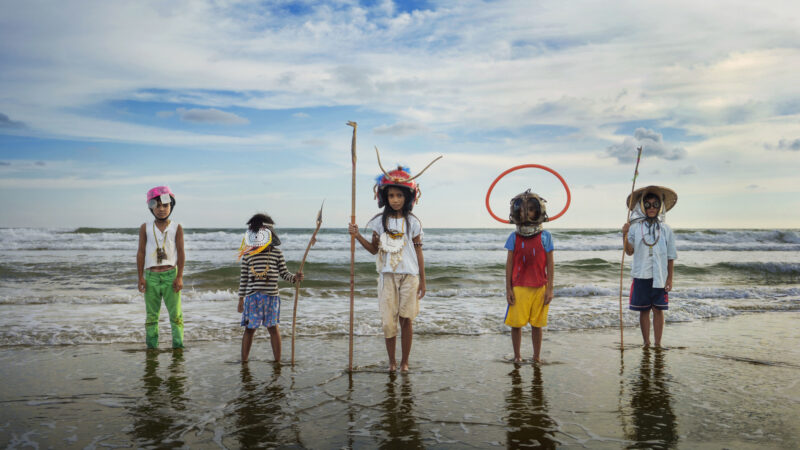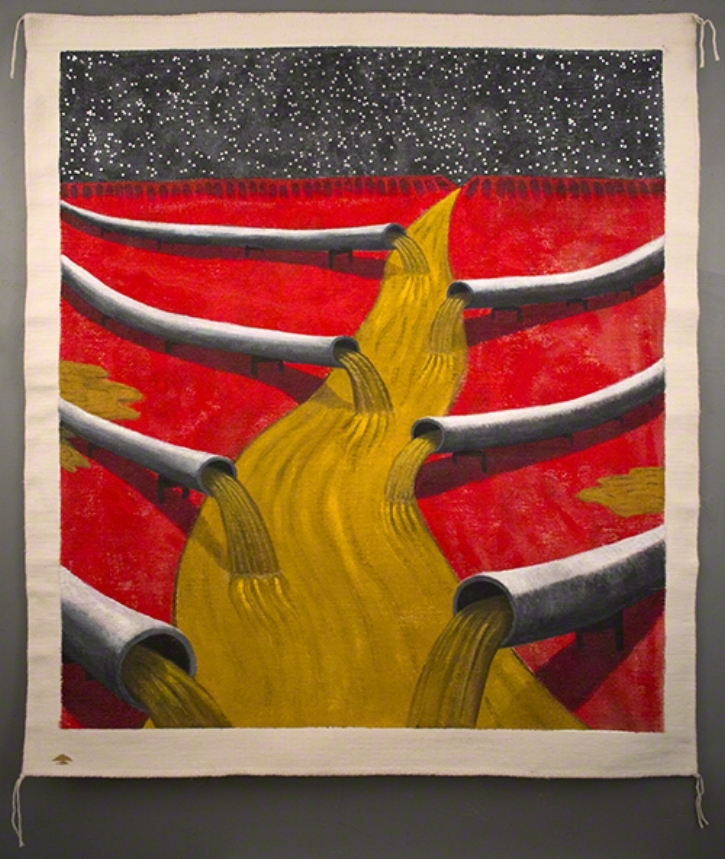Water, Art, and Their Inseparable Histories
Review of Our Blue Planet: Global Visions of Water presented by Seattle Art Museum
Written by Teen Writer Stella Crouch and edited by Teen Editor Disha Cattamanchi

Our Blue Planet: Global Visions of Water is a temporary exhibit at the Seattle Art Museum (SAM), chronicling the privileges and powers humanity has over water. The exhibit features works from a wide array of mediums including photography, film, painting, sculpture, and various textiles, analyzing the sustaining role water has played in the past, and what that can mean moving forward.
Pushing the boundaries of what a single exhibit can be, Our Blue Planet contains the works of 74 artists from numerous countries and Indigenous tribes. The exhibit is not limited by a certain medium, location, point of view, age, or history; rather, it embraces the duality of art forms to create an immersive experience. The multitude of forms the exhibit takes emphasizes the universal need for a healthy planet. Ultimately, the exhibit comments there is no place or person who will not be affected by climate change.
Introducing the exhibit is a film featuring Ken Workman, a Duwamish tribal member and descendant of Chief Sealth. Speaking in both Lushootseed and English from the banks of the Duwamish river, he introduces us to the history and meaning of water for the Duwamish people. It is conspicuous that Workman addresses visitors directly in Lushootseed as it highlights Indigenous languages and their suppression through colonization. Much like preserving Indigenous art, preserving Indigenous languages is an act of resistance. Workman has spoken on the power of passing down stories and traditions through generations and how it is central to the Duwamish practice of caring for and bonding with tribal members. People can learn from their elders and hopefully in turn take their place someday.
After entering the exhibit, printed on the wall in big, bold letters is the stark and wondrous fact that water covers over 70% of the surface of the Earth, hence Earth’s nickname, the “Blue Planet.” Water not only surrounds us, incorporated into our daily lives, but also makes up the majority of our bodies as well. Whether the viewer already knows these facts or is learning them for the first time, their inclusion ensures that water’s importance in the Earth’s ecosystem is at the forefront of visitors' minds throughout their exhibit experience.
The exhibit questions what water means to different people without external pressures or exploitation. Water has been commodified in so many ways that it is hard to think about it in a non-capitalist way. Something I observed throughout the exhibit was an attempt to highlight the drastic contrariety between ethical and exploitative uses of water. The artworks did this by portraying the original and sustainable practices of Indigenous tribes maintaining a healthy environment, and providing water for their community. The exhibit contrasted this with the wasteful capitalistic practice of water as a means of generating profit, increasing geopolitical power, and garnering wasted resources. This is evident in a hallway containing photographs by artists Vivan Sundaram and Edward Burtynsky that depict petrol pipes and industrial machines surrounded by landscapes of mountains, plants, animals and bodies of clear water. At first I felt that the photographs were unfamiliar to me until I looked at them long enough and realized that I had seen similar machinery and industry mostly the same throughout the world. It is clear that the ecosystems in the photographs were not respected by society in the name of progress and extraction of resources. This has led to topography being the only way to distinguish the different landscapes in the pieces, as everything around them becomes increasingly monotonous and plain.

The section Desecration of Our Troubled Waters details topics such as environmental racism, industrial illness, and climate refugees. One piece that particularly stood out to me was Desecration #2 which was created by John Feodorov, a Diné artist, as a part of his “Desecration” series. The collection of four paintings chronicles the disproportionate impact of pollution and climate change on Indigenous people. Utilizing traditional Diné wool rugs as a canvas, Feodorov uses graphite, paints and Conté crayons to depict a myriad of broken pipes spilling orange-yellowish liquids into a long, flowing river. The Conté crayons, often thought of as sacred, represent the original Diné culture, highlighting the ongoing environmental threats from governmental and private forces.
The exhibit reiterated that forward progress was only possible if we acknowledge the histories, practices and experiences of Indigenous communities. A powerful example of this was a display of Australian Aboriginal paintings constructed out of eucalyptus bark and metals, with natural pigments and graphic etching. One example of this was Yarrinya by Barayuwa Mununggurr of the Diapu clan of Northeast Arnhem Land. Yarrinya is a depiction of the choppy patterns on the surface of water, which are believed to be a sign of ancestral power and creativity by the Diapu people. The art piece is a compilation of sacred clan designs telling the story of an ancestral whale who was killed and left to decay. The skeleton of the whale's tail was recovered and preserved, becoming the basis of a ceremony still practiced today. The piece as a whole warns humans about the dangers of excessive hunting and exploitation of the oceans.
In the same room as the metal etchings we are also introduced to Sea Bear a mixed media installation that represents a polar bear of the sea. Composed of wood, beads, and shells, Sherry Markovitz designs the piece to come out of the wall like a bust of a trophy animal. Ironically, I felt like the striking piece was watching me, hung high on the wall with its shadow casting across the museum. Upon reading more about the piece, I learned Markovitz created Sea Bear in 1990 after giving birth. She was inspired by the senses she felt while walking along a beach. The persona of the “Sea Bear” became a guardian to her, providing peace and consistency in a fast-changing and unfamiliar time, emerging from the sea adored in a driftwood necklace with pearls. There was something comforting about the water and the constant motion. The tides and changing intensity of the painting reflected the variety in humanity.
Our Blue Planet contains works that are hopeful as well as bleak. Displayed artworks showcase the climate change, human waste, and systemic oppression that plagues our waters. This exhibit introduced me to many artistic and historical practices, having me take more notes than I usually do at museums. While I don’t think personal research is imperative following the exhibit, I would nonetheless recommend it. Being confronted by my anxiety about the fate of our planet inspired me to examine our collective impact, without shifting the blame from major corporations that contribute to pollution. I am comforted by the reminder that I am not alone in these trepidations. The exhibit highlights the diversity of the people that have inhabited cultural lands for thousands of years and how water is intrinsically linked to our history.
Lead Photo: The Arrival of The Boat People (2020) by Tuan Andrew Nguyen, pigment print on Hahnemuhle paper. Photo courtesy of the artist and James Cohan, New York.
The TeenTix Newsroom is a group of teen writers led by the Teen Editorial Staff. For each review, Newsroom writers work individually with a teen editor to polish their writing for publication. The Teen Editorial Staff is made up of 6 teens who curate the review portion of the TeenTix blog. More information about the Teen Editorial Staff can be found HERE.
The TeenTix Press Corps promotes critical thinking, communication, and information literacy through criticism and journalism practice for teens. For more information about the Press Corps program see HERE.


